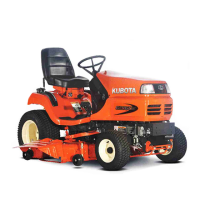Why does my Kubota Lawn Mower emit bluish white smoke?
- AAlicia MckeeSep 4, 2025
If your Kubota lawn mower emits bluish-white smoke from the muffler during operation, it's likely due to too much engine oil. Check and reduce the engine oil level.

Why does my Kubota Lawn Mower emit bluish white smoke?
If your Kubota lawn mower emits bluish-white smoke from the muffler during operation, it's likely due to too much engine oil. Check and reduce the engine oil level.
What to do if my Kubota G2160E moves when the speed control pedal is not depressed?
If your Kubota lawn mower moves when the speed control pedal is not depressed while the engine is running, the hydrostatic neutral system is probably not correctly adjusted. You should adjust the hydrostatic neutral system.
What to do if my Kubota Lawn Mower engine stops suddenly?
If your Kubota lawn mower engine stops suddenly, it's likely due to insufficient fuel. Refill the fuel tank.
How to fix belt slipping on Kubota G2160E?
Belt slippage on your Kubota lawn mower can occur due to incorrect belt tension, a plugged mower deck, debris in the pulleys, or a worn belt. To address this, adjust the belt tension, clean the mower deck, clear debris from the pulleys, or replace the worn belt.
What to do if my Kubota G2160E Lawn Mower won't idle?
If your Kubota lawn mower won't idle, the fuel filter is likely clogged. Replace the fuel filter.
What to do if my Kubota Lawn Mower is vibrating excessively?
| Brand | Kubota |
|---|---|
| Model | G2160E |
| Category | Lawn Mower |
| Language | English |
Defines the proper and intended operational purpose of the machine.
Emphasizes safety warnings and the importance of reading instructions before use.
Essential checks and knowledge required before starting the machine.
Procedures for starting, working, and general operation of the machine.
Critical safety guidelines and precautions for operating the machine on inclines.
Safety procedures for engaging and operating the Power Take-Off (PTO) system.
Guidelines and precautions for safely transporting the machine.
Safety guidelines to follow when performing maintenance and repairs.
Proper procedures for storing the machine to maintain its condition.
Identification and explanation of various safety labels affixed to the machine.
Details regarding the machine's warranty coverage and applicable conditions.
Guidelines for safely decommissioning and disposing of the machine.
Technical details and specifications related to the machine's engine.
Fluid capacities for engine oil, fuel, coolant, and transmission systems.
Physical measurements and key dimensions of the machine.
Technical details and specifications related to the mower deck attachment.
Maximum loading weights and compatibility guidelines for attachments.
Guidance on adding ballast for stability and safe operation of the machine.
Operation and function of throttle, key switch, and speed control pedal.
Operation of brake, parking brake, seat adjustment, and suspension.
Operation of PTO lever and hydraulic lift lever for mower and implements.
Explanation of dashboard warning lights, hour meter, and overheat alarm.
Step-by-step instructions for connecting the mower deck to the machine.
Procedure for setting the mower deck parallel to the ground for an even cut.
Instructions for leveling the mower deck from side to side.
Detailed steps and safety checks for starting the engine.
Procedures to verify the safety interlocks for starting the engine.
Verifying the Operator Presence Control safety system.
Correct procedure for shutting down the engine safely.
Importance and procedure for warming up the engine before use.
Safe instructions and precautions for jump-starting a dead battery.
Basic instructions for driving the machine forward and backward.
How to safely bring the machine to a complete stop.
Procedures for safely parking the machine on level or inclined surfaces.
Guidelines and warnings regarding towing the machine.
How to set the desired grass cutting height using the control dial.
Schedule of recommended maintenance tasks based on operating hours.
Recommended lubricants, capacities, and their application points.
Essential checks to perform before each operation to prevent issues.
Procedures for checking engine oil level and amount of fuel.
Checking radiator, cleaning screens, and oiling key points.
Maintaining correct tire pressure and checking brake pedal operation.
Checking fan belt tension and battery condition.
Cleaning air cleaner element and checking fuel filter.
Procedures for changing engine oil and transmission fluid.
Inspection of radiator hoses, hydraulic hoses, and intake air lines.
Maintenance tasks for 500, 1500, 3000 hours and 1 year intervals.
Engine overheating precautions, cooling system cleaning, and antifreeze handling.
Tasks for 2-year intervals, service as required, and bulb replacement.
Procedure for checking, replacing mower blades, and mower belt replacement.
Table of torque values for various bolts and screws based on size and grade.
Steps to prepare the machine for operation after a period of storage.
Common engine problems, their probable causes, and corrective measures.
Common battery issues, their probable causes, and corrective measures.
General machine operational problems, their probable causes, and solutions.
Troubleshooting specific issues related to the mower deck.
Measured sound pressure and vibration levels according to EN836 standards.